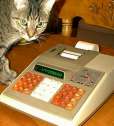Hewlett-Packard HP-21S
| Datasheet legend
Ab/c:
Fractions calculation
AC: Alternating current BaseN: Number base calculations Card: Magnetic card storage Cmem: Continuous memory Cond: Conditional execution Const: Scientific constants Cplx: Complex number arithmetic DC: Direct current Eqlib: Equation library Exp: Exponential/log functions Fin: Financial functions Grph: Graphing capability Hyp: Hyperbolic functions Ind: Indirect addressing Intg: Numerical integration Jump: Unconditional jump (GOTO) Lbl: Program labels LCD: Liquid Crystal Display LED: Light-Emitting Diode Li-ion: Li-ion rechargeable battery Lreg: Linear regression (2-var. stats) mA: Milliamperes of current Mtrx: Matrix support NiCd: Nickel-Cadmium recharg. batt. NiMH: Nickel-metal-hydrite rech. batt. Prnt: Printer RTC: Real-time clock Sdev: Standard deviation (1-var. stats) Solv: Equation solver Subr: Subroutine call capability Symb: Symbolic computing Tape: Magnetic tape storage Trig: Trigonometric functions Units: Unit conversions VAC: Volts AC VDC: Volts DC |
| ||||||||||||||||||||||||||||||||||||||||||||||||||||||||
Hewlett-Packard HP-21S
 The HP-21S is another fine calculator from Hewlett-Packard's Pioneer series; it's a close relative to the HP-20S. However, unlike the HP-20S, which is still manufactured, the HP-21S is no longer in production.
The HP-21S is another fine calculator from Hewlett-Packard's Pioneer series; it's a close relative to the HP-20S. However, unlike the HP-20S, which is still manufactured, the HP-21S is no longer in production.
There are to main differences between these calculators. First, scientific functions on the HP-20S, such as hyperbolic functions, unit conversions, or number base calculations are replaced with advanced statistical functions on the HP-21S; second, the set of built-in programs differs between the two machines.
Like the HP-20S, the HP-21S is also an algebraic calculator. A shame, really; algebraic entry just looks out of place on a fine HP instrument.
The keystroke programming model of the HP-21S is essentially identical to that of the HP-20S. Most keys are common between the two machines, so many programs are interchangeable. This is certainly true in the case of the Gamma function program example I wrote for the HP-20S.
Rather than repeating that program here, I have an alternative: the incomplete Gamma function. This program can also be used to approximate the Gamma function, by entering a high enough integration limit. For instance, 5 INPUT 50 XEQ A yields 24, which is the exact value of the Gamma function for the argument 5.
01 - 61 41 A LBL A 02 - 21 1 STO 1 03 - 51 31 SWAP 04 - 21 2 STO 2 05 - 71 C 06 - 22 1 RCL 1 07 - 14 yx 08 - 22 2 RCL 2 09 - 45 ÷ 10 - 22 2 RCL 2 11 - 74 = 12 - 21 4 STO 4 13 - 21 3 STO 3 14 - 61 41 1 LBL 1 15 - 22 3 RCL 3 16 - 55 × 17 - 22 1 RCL 1 18 - 45 ÷ 19 - 1 1 20 - 21 75 2 STO+ 2 21 - 22 2 RCL 2 22 - 75 + 23 - 21 3 STO 3 24 - 22 4 RCL 4 25 - 21 5 STO 5 26 - 74 = 27 - 21 4 STO 4 28 - 65 - 29 - 22 5 RCL 5 30 - 74 = 31 - 61 43 x=0? 32 - 51 41 2 GTO 2 33 - 51 41 1 GTO 1 34 - 61 41 2 LBL 2 35 - 22 4 RCL 4 36 - 45 ÷ 37 - 22 1 RCL 1 38 - 12 ex 39 - 74 = 40 - 61 26 RTN


